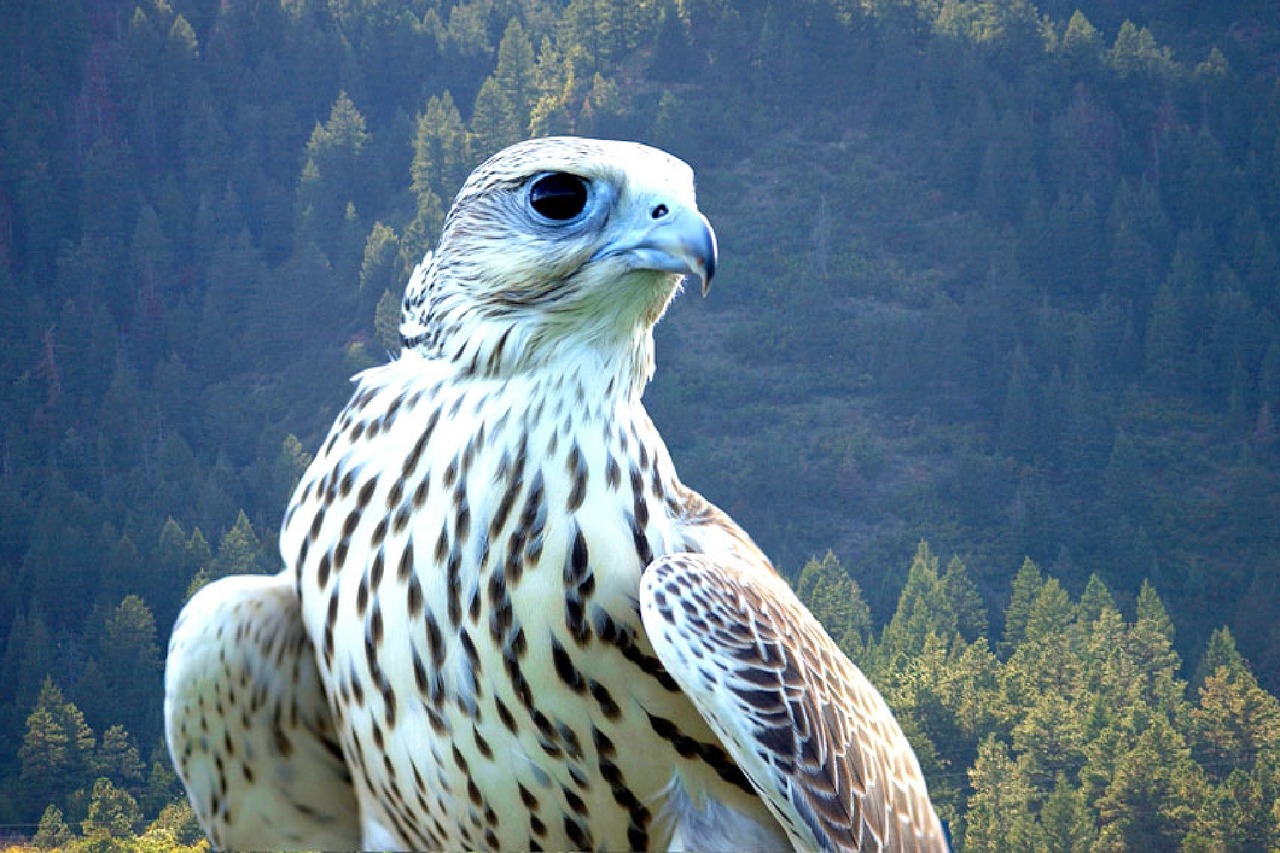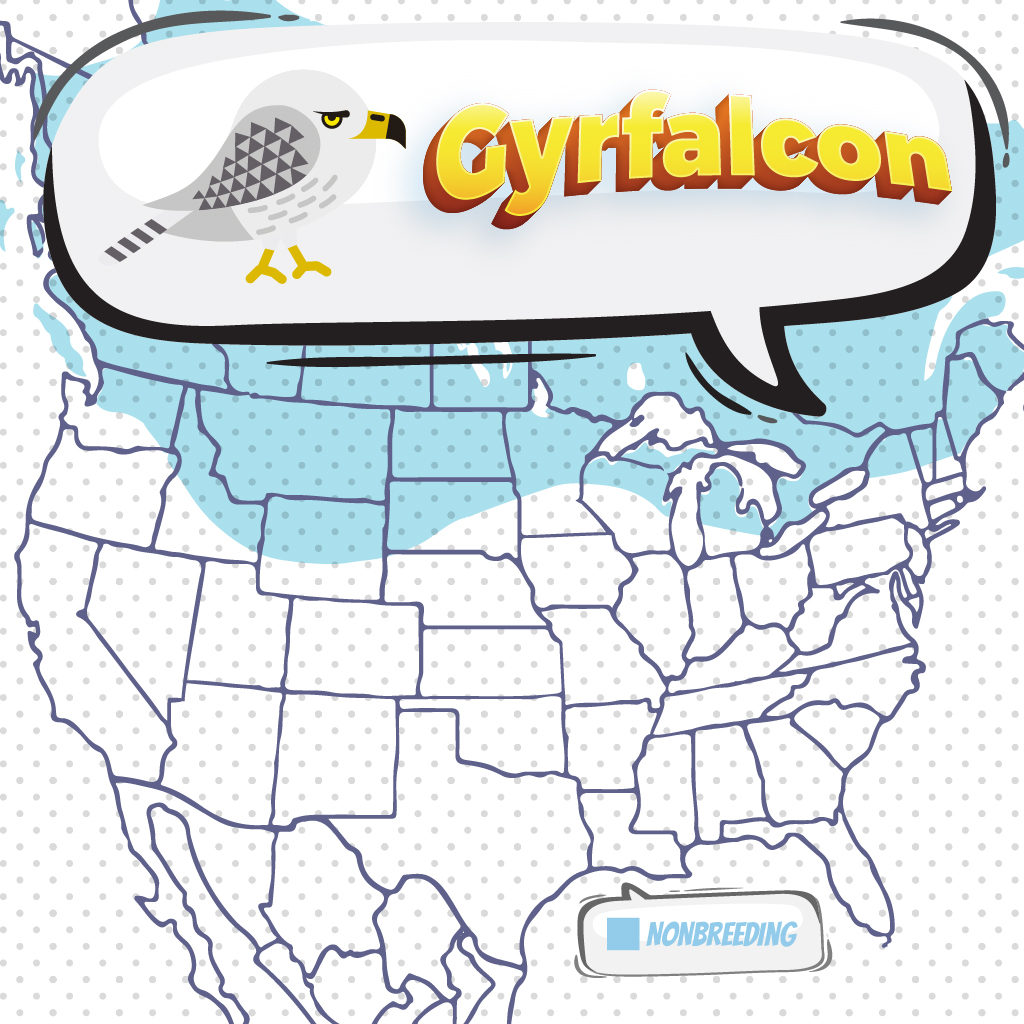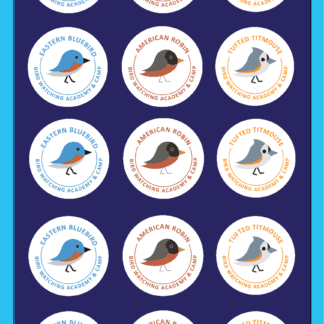
Gyrfalcon
A Gyrfalcon is a fun bird to see while bird watching. Below are some tips to help you identify Gyrfalcons. We have also put together a list of fun Gyrfalcon t-shirts, Gyrfalcon bird patches, bird houses, bird feeders, binoculars, stickers and other fun bird watching items.
About Gyrfalcons
This is the largest of the falcon species. It breeds in the Arctic coast and Tundra along with the islands of North America, Europe, and Asia. After mating season, the birds take off on their own and fly over long distances, which makes them get sparse and distributed over large areas.
Description and Identification
Gyrfalcons are large falcons with wings that are pointed, but not as narrow when
compared to smaller falcons. Their bodies are thick and powerful with long tails. Like most
falcons, this species exhibits distinct sexual dimorphism, with females being bulkier and
larger than males. These birds also display polymorphism – a genetic characteristic
wherein two or more phenotypes affect the visual appearance of a creature – in their
plumages, resulting in a wide variety of coloured birds. They can be coloured in any shade
within a spectrum of all white to black, with white, silver, brown, and black as the most
frequent plumages observable to the Gyrfalcons. There are no sex-based colour differences,
although the black colour seems to be the most prevalent among females. Juveniles tend to
be darker and browner than adults. Adults are heavily barred on the back, wings, and tail, while juveniles are heavily streaked.
Gyrfalcon Size
Males: Length: 48 to 61 cm, Weight: 1350 grams, Wingspan: 110 to 130 cm
Females: Length: 51 to 65 cm, Weight: 1752 grams, Wingspan: 124 to 160 cm

Gyrfalcon Appearance
The Gyrfalcon is a polymorphic species and therefore its plumage varies greatly. Their colors run from pure white to night black. The general colors are said to be white, silver, brown, and black. The brown color, which occurs mostly in females, is mixed with cream streaking on the crown and nape of the bird. The black morph has a black-spotted underside. The white morph is the only form that is pure in color and has no other markings. The silver morph is basically just a metallic shade of gray.
What Gyrfalcon Eat
Gyrfalcons feed on smaller birds and small mammals primarily, with this species consuming
more mammals than most other birds in the Falco genus. They mainly consume Willow
Ptarmigan and Rock Ptarmigan, but also consume birds like waterfowl, shorebirds, and
songbirds. Their diet, however, is quite versatile and they have been known to capture birds
like hawks, ravens, owls, crows, other falcons, and magpies. The mammals that they consume mainly include hares, squirrels, and the arctic fox. Their excellent eyesight allows
them to spot their prey from high elevations and dive down to swiftly catch it.
They are strictly carnivorous, feeding on birds and mammals. Their preference is mammals and they can hunt and kill mammals three times their body weight.
They hunt in a horizontal pursuit pattern and force their prey to the ground where the killing is done, regardless of whether it’s a bird or a mammal. It eats mammals such as hares and squirrels.
Where Gyrfalcons Live
These falcons breed in the arctic and alpine tundra around the Arctic circle, frequently visible
in Alaska and Northern Canada. During the other seasons, they can be spotted in areas
much higher than the Arctic circle and have been observed to frequently winter over frozen
seas. They are dependent on regions with abundant amounts of seabirds and waterfowl, and
thus mainly inhabit rocky seacoasts, offshore islands, barren lands with rocky outcrops, river
bluffs, lake bluffs, and mountainous elevations more than 5,000 feet in elevation. They are
sometimes found in the edges of boreal forests or on the spruce strands by beaches. During
the winter, they linger in lower altitudes and may move southwards.
They can be found mainly in tundra and mountainsides. However, various gyrfalcons have been spotted during winter on the sea ice far from land.
Range and Migration

The majestic Gyrfalcons are the largest falcons in the world, primarily found in the tundra
regions around the high Arctic. They inhabit areas in and around the Arctic circle and were
once thought to be birds that are found in the tundra and mountainous regions only, until a
A 2011 study revealed that some flocks spend considerable amounts of time on the sea ice
during winters. These birds are non-migratory, and most adults are considered to be
permanent residents of the high north, although some juveniles and adult breeders might
migrate to regions as south as southern Canada. Due to climate change, the European
populations of the Gyrfalcons have dwindled while remaining fairly stable in North America.
Gyrfalcon Lifecycle
During breeding, the Gyrfalcons take up other birds’ nests, usually the golden eagle in mountain cliffs. The younglings live in the nests for up to 7 to 8 weeks, then become fully independent after 3 to 4 months.
Gyrfalcons are naturally aggressive predators and are known to attack anyone or any animal that comes close to their young. The only known predator for these falcons is the golden eagle.
Gyrfalcon Nesting
Gyrfalcons nest in cliffs or in the conifer tree nests of other species like the Golden Eagle or
the Common Ravens. They may nest directly on the cliff ledged while being protected by
overhangs oriented away from the wind. The nests usually range from bare to debris-
covered soil with depressions in them that are structured by dead sticks and have very little
to no lining at all. Although these falcons do not build nests for themselves, both males and
females contribute to making depressions within the site. The average clutch size is between
1 – 5 eggs with an incubation period of roughly one month.
Ornithology
Bird Watching Academy & Camp Subscription Boxes
At Bird Watching Academy & Camp we help kids, youth, and adults get excited and involved in bird watching. We have several monthly subscription boxes that you can subscribe to. Our monthly subscription boxes help kids, youth, and adults learn about birds, bird watching, and bird conservation.
Bird Watching Binoculars for Identifying Gyrfalcons
The most common types of bird watching binoculars for viewing Gyrfalcons are 8×21 binoculars and 10×42 binoculars. Bird Watching Academy & Camp sells really nice 8×21 binoculars and 10×42 binoculars. You can view and purchase them here.
Gyrfalcon T-shirts
If you love the Gyrfalcon you should purchase a Bird Watching Academy & Camp T-shirt. To help support bird conservation we donate 10 percent to bird conservation activities.
Gyrfalcon Iron On Patches
Kids, Youth, and Adults love to collect our Bird Watching Academy & Camp iron on patches. Our bird watching patches help you keep track of the birds you have seen an identified. You can also display the patches on our Bird Watching Academy & Camp banners.
The Gyrfalcon is a great iron on patch to start your collection with. The patches are durable and can be sewn on or ironed on to just about anything.
Gyrfalcon Stickers
Stickers are a great way for you to display your love for bird watching and the Gyrfalcon. We sell a monthly subscription sticker pack. The sticker packs have 12 bird stickers. These sticker packs will help your kids learn new birds every month.
Bird Feeders For Gyrfalcon
There are many types of bird feeders. Here are our favorite bird feeders for your backyard. We use all of these bird feeders currently. Kids will have a great time watching birds eat at these bird feeders. Using this collection of bird feeders will provide a wide variety and many types of birds.
Best Bird Houses for Gyrfalcon
There are many types of bird houses. Building a bird house is always fun but can be frustrating. These 4 bird houses have become our favorites. Getting a bird house for kids to watch birds grow is always fun. We spent a little extra money on these bird houses but they have been worth the higher price and look great.











